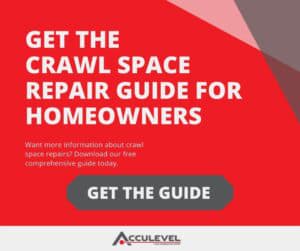Have Water in Your Crawl Space?
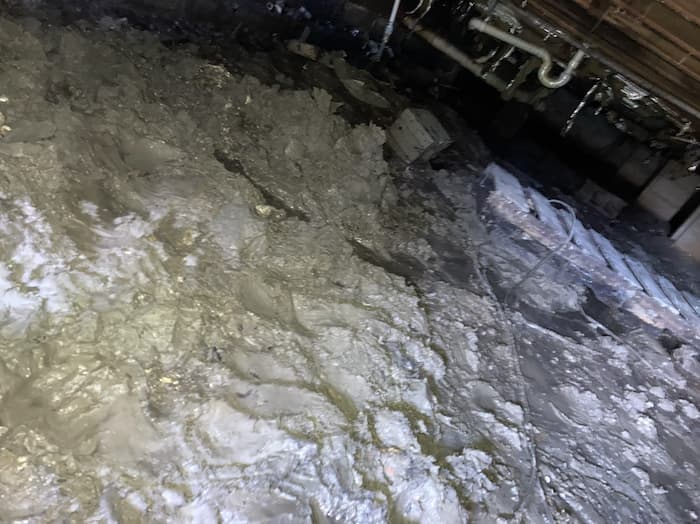
Originally posted 9/8/21; updated 8/9/23
When it rains, water may seep into your crawl space. This is normal and happens pretty regularly; the crawl space floor is probably open to the dirt below your house. But just because it’s typical to have water in the crawl space does not mean you should ignore water in your crawl space! Moisture can have a devastating effect on your home, your health, and your foundation.
Since our start in 1996, Acculevel has been helping homeowners protect and preserve their homes. We’re a family-owned and operated company and we specialize in waterproofing and foundation repair. We’ve helped more than 35,000 families restore health and stability to their homes, and we want to share our knowledge and experience with you.
We understand that it’s easy to ignore your crawl space. It’s not a space that you actively use or decorate for curb appeal. For most homes, the crawl space is just the access point for your utility repairs or maintenance. But if you have a damp crawl space, you have serious trouble brewing under your home.
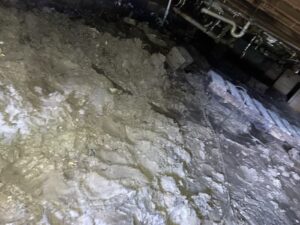
This photo was taken by an Acculevel project advisor during a whole-home inspection; the homeowner had standing water and strong odors in their crawl space.
A Wet Crawl Space Causes Sagging Floors
When there is water in a crawl space, there’s moisture in the air. It doesn’t take a lot — just a puddle or two creates enough water vapor to make the walls and the ceiling damp. How can that small amount of water damage your home? Easily — because the “ceiling” includes the wooden structure of your home. What happens when wood gets damp? It starts to soften and decay.
Crawl Space Pests and Wood Rot
This is a major problem for you for two reasons. First, because softened wood is an ideal environment for pests like termites or carpenter ants, which will further damage the wood supports. Second, that damp wooden structure is expected to support the weight of your entire home and all of its furnishings. Damp wood compresses over time, causing the boards to shrink and settle.
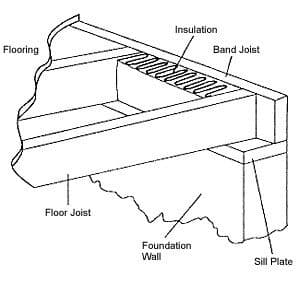
This is an illustration of the supporting structure below your home’s carpet or tile.
(Image courtesy of NCSU)
When the structural integrity of these components is compromised, they begin to creak and sag. People often think sagging and creaking are normal in older homes — and they are! But it’s not due to age alone; it’s wear and tear on the structure caused by moisture and decay.
If you have sagging or sloping floors, you’ll need to have this entire structure evaluated to determine the weak spots. Repair methods and costs will vary, depending on which components need to be fixed.
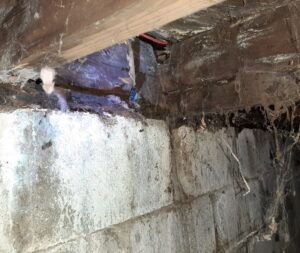
This photo was taken by an Acculevel project advisor during a crawl space inspection. The sill plate, band board, and floor joists are rotting, with mold and water damage.
Damp Insulation Is Another Frequent Problem
Have you heard the saying, “hindsight is twenty-twenty?” It indicates that when we look back on actions, we see more clearly. This is true for everyone, including the insulation industry. Fiberglass batting has been the primary method of insulation for years, but we know now that it’s a terrible choice for crawl spaces.
Fiberglass Insulation Absorbs Water
It acts just like a sponge; fiberglass batting can and will absorb moisture, which is harmful to your home in a variety of ways. As it takes in water, it’s keeping damp material pressed against the wood joists, band board, and main beam. Since we just discussed the effect of moisture on wooden beams, you know how bad this is.
Eventually, the added weight of the water will pull the insulation down. So you paid for an insulated floor, but now you have debris on the ground. Damp fiberglass batting can attract insects and other pests like small animals looking for nesting material. (And you know these unwanted guests create their own invasive issues!)
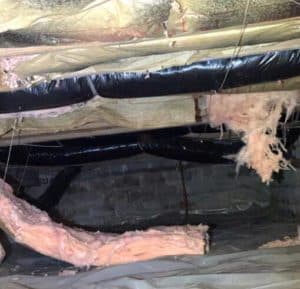
This photo was taken by an Acculevel project advisor. The fiberglass insulation is damp, growing mold, and has started falling down.
This also leaves your floors unprotected in the winter. Without consistent insulation, your floors will be cold, you’ll be uncomfortable, and have to bump up the thermostat setting to compensate. This means your HVAC will be less efficient, so it will work harder and run more frequently. You’ll have higher energy bills and more wear and tear on your furnace; neither of these are good for your wallet.
Spray Foam Insulation Is the Ideal Alternative
To avoid these issues or prevent them from happening in the future, we recommend that homeowners replace fiberglass with spray foam insulation. Spray foam repels water, fills every gap, adheres wherever it’s applied, discourages mold growth, and has a life expectancy of 80+ years.
Water in A Crawl Space Compromises Indoor Air Quality
Insects and rodents aren’t the only pests that can flourish in your home’s crawl space. A little water in a crawl space can feed other organisms that damage humans more directly. Remember: the air in your home isn’t kept separate from the air in your crawl space. Your house isn’t airtight between levels, and even if it was, your HVAC ductwork connects the two spaces.
Mold, Dust Mites, and Mildew Growth
Pollen, mold spores, dust mites, and other allergens are everywhere in our environment. Some of these — especially molds and mildews — particularly like water in the crawl space. All these organisms need is a source of moisture and food (dust and other human debris are food sources). These biological growths can trigger allergies and cause grief for both allergy sufferers and asthmatics.
Odors, Vapors, and Gasses
Because your home’s foundation is open to the dirt crawl space “floor,” anything that is in the soil will make its way into your air. You should have a vapor barrier installed to cover the dirt and block the worst of these fumes from evaporating into your space. A vapor barrier is a heavy sheet of vinyl or plastic and needs to be replaced every 5-10 years.
You may need to repair or replace this barrier more frequently if heavy rain normally leads to pooling water in your crawl space. Frequent water in a crawl space will cause vapor barriers to be displaced or break down more quickly.
Viruses And Bacteria
Other health problems can result from threats like viruses and bacteria, which happily grow in a damp space. And no one is immune to these airborne threats!

Information taken from a study performed by ASHRAE (the American Society of Heating, Refrigerating and Air-Conditioning Engineers.)
You can see in the table above that the best humidity level in a crawl space is around 50%. This is when your crawl space is the healthiest.
Whole-Home Dehumidifier
If you don’t regularly have standing water or have never had a flooded crawl space, you may only need to install a high-quality home dehumidifier to eliminate excess moisture. Unlike the smaller appliances you buy at a home goods store, a whole-home dehumidifier won’t need you to regularly empty the water collection bucket. This type of dehumidifier has a discharge line that can be routed to your sump pump system to automatically remove the water for you.
The model Acculevel installs is large enough to cover most homes (up to 5,000 square feet). Our dehumidifier has a manufacturer warranty for 5 years, can remove 95 pints per day, and has an average life expectancy of 15 years.
Water in Your Crawl Space Damages Your Foundation
We all learned the basics about erosion in school. But many homeowners don’t realize that erosion can happen to your home, even if you don’t live in a high water table (or near a body of water). All you need is enough rain to oversaturate the soil around your home. Once there’s excess water in the ground, the soil starts to move. And since your crawl space is open to the soil below your home, any water that seeps in has easy access to your foundation.
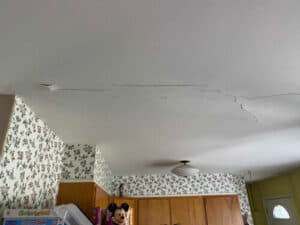 This photo was taken by an Acculevel project advisor during a home evaluation. Thin cracks in the ceiling or walls of your home are indications of a settling foundation.
This photo was taken by an Acculevel project advisor during a home evaluation. Thin cracks in the ceiling or walls of your home are indications of a settling foundation.
When the soil under your home’s foundation shifts, it sometimes causes uneven settling. This means one of your foundation walls or corners sinks farther or faster than the others. Uneven settling can cause major structural issues because your home is designed to be level. All the materials used in construction are designed to be rigid and hold firm — they aren’t flexible at all. So when a portion of the foundation pulls against the rest of the home, it causes cracks to form, timbers to warp and your window and door frames to shift.
The best way to repair a house with a settling foundation is with helical piers. We go into greater detail about settling foundation problems and repair methods in this article.
Crawl Space Water Problems Should Be Addressed Promptly
We strongly recommend interior waterproofing for any home with water in the crawl space. The threats of water damage to the house, its foundation walls, and indoor air quality are just too significant to risk.
Waterproofing
Acculevel has a specific type of water drainage, called GeoChannel, that is designed to control water in the crawl space. The drainage track is wrapped in fibers that filter out dirt and debris to prevent any clogs from forming.
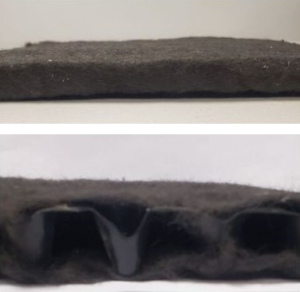
These are photos of a GeoChannel section taken by the author.
The drainage track is routed to a sump pump system, which will expel the water out of the crawl space through a discharge line. At Acculevel, we install a battery backup with every sump pump to protect our customers in the event a power outage occurs.

This photo was taken by an Acculevel team member, after installing GeoChannel water drainage and a sump pump in a crawl space.
Encapsulation
If you or someone in your family has asthma or other chronic respiratory ailments, encapsulation is the ideal solution for a clean and dry crawl space. This process starts with waterproofing, then adds full coverage of the crawl space (walls & floor) with a heavy-duty liner that keeps all moisture out of the crawl space. This liner eliminates the need for a vapor barrier, as it is significantly more durable and effective.
The encapsulation liner Acculevel uses is a polyurethane membrane interlaced with high-density fibers. This material is inorganic, so it won’t support any mold or biological growth. It’s also the strongest and most puncture-resistant encapsulation material currently available in the market.
The encapsulation liner is sealed around the perimeter with spray foam insulation, and a whole-home dehumidifier is the final piece necessary. Once your (formerly) wet crawl space is fully encapsulated, you will have a clean and dry space that protects your house and everyone who lives in it.
Do You Have More Questions About Your Crawl Space?
Please don’t hesitate to dive into our homeowner’s guide to crawl space repairs. This free resource covers all the topics we’ve discussed here, but in greater detail and with more information.
Learn how to:
- Prevent water from collecting around your home with downspout extensions
- Avoid costly repairs associated with mold and water damage
- Calculate potential costs for repairs you need
- Find the right contractor and products for you
If You Need A Professional to Evaluate Your Crawl Space
Contact Acculevel by completing our online form or calling 866-669-3349. Our service area includes Indiana and portions of the surrounding states (we recently expanded into Cincinnati).
Live outside of our service area? Get recommendations from friends, neighbors, or your local realtor for reputable contractors. Make sure they are insured and accredited by the Better Business Bureau, and check their reviews on Google, Facebook, and other sites like Home Advisor.

